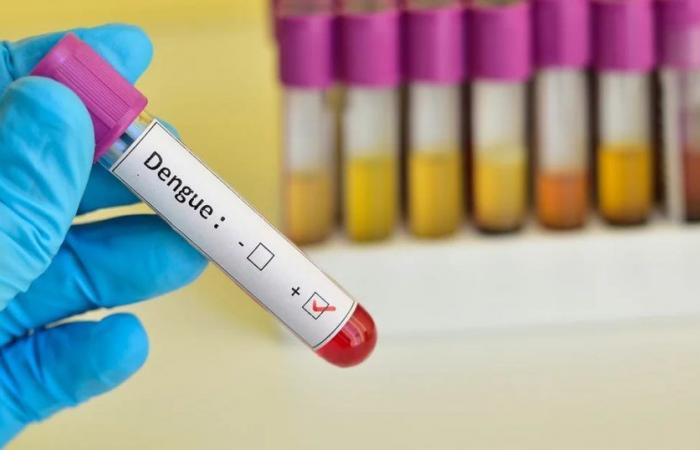The Ministry of Health released new data on the incidence of dengue in Argentina. “In cumulative terms, they have been notified from week 31 of 2023 -end of July and beginning of August- to week 23 of 2024. -beginning of June- 526,030 cases of dengue (95% indigenous, 3% in research and 2% imported), of which508,867 (97%) correspond to the year 2024. The accumulated incidence so far for the season is 1,118 cases per hundred thousand inhabitants”reported on the viral disease transmitted by mosquito Aedes aegypti.
“Of the total cases registered during week 23 of 2024 (4,284), only 133 correspond to said epidemiological week by minimum date. In the same period, 1,220 cases were classified as severe dengue (0.23%) in 21 jurisdictions and were registered 366 deceased cases in 18 jurisdictions, with a fatality rate of 0.070% so far (355 cases belong to the year 2024)”, they detailed in the Epidemiological Bulletin.
And they stated that it is recorded, “in an analysis at the country level, a decrease in the number of cases from 9 weeks ago -after the 3 weeks with the highest number of cases, between weeks 12 and 14 (between mid-March and early April) when an average of 60,514 weekly cases were recorded.”
Secondly, in the document they made the following parallel: “The accumulated cases until week 23 represent 3.29 times more than what was registered in the same period of the previous season -2022/2023- and 8.01 times more than registered in the same period of 2019/2020″.
Regarding the situation by region, the health portfolio stated: “The highest accumulated incidence so far is that of the NOA region with 2,048 cases per 100,000 inhabitants, followed by the NEA with 1,588, Center with 1,071, Cuyo with 288. ; and, South with 48 cases per 100,000 inhabitants. Regarding the contribution of absolute cases, the Central region contributed 61.6% of all reported cases, followed by the NOA regions with 23.1% and NEA, with 13.1%, while the Cuyo and South contribute 2.2%.”
Meanwhile, regarding the serotypes of the virus, they showed that in the current season “3 serotypes have been identified in autochthonous cases, with a predominance of DEN-2 / more than 56%), followed by DEN-1 (more than 43% (among both concentrate more than 99.9% of the cases) and a few cases of DEN-3 registered at the beginning of 2024.”
Weeks ago, as he told Infobaethe Ministry of Health released a series of strategies against dengue and how he proposes get ahead of a possible next outbreak in the 2024-2025 season.
The minister Mario Russo structured the plan against supported by three fundamental pillars: the experts of the National Immunization Commission (CoNaIn) and its scientific recommendations for the use of the available vaccine and epidemiological surveillance, among others; On the other hand, tailored and specific work in each territory that must be planned by the country’s jurisdictions, which will receive transfers from the Nation – money items, for example through the SUMAR program – based on the achievement of goals.
Russo also sat at the table at Pan American Health Organization (PAHO) in its dual role as a trustworthy and observatory body in matters of local-regional-global public health and also to guarantee access to vaccines through the revolving fund.
Previously, in dialogue with Infobae, Russo explained: “We will start progressively and in stages – approximately starting August 2024– in the endemic areas of the NEA and NOA, with vaccination against dengue for young people between 15 and 19 years old, that the State will provide. It will be a joint task with each of the jurisdictions and the consensus that we achieve with the experts.
The vaccine will not be part of the National Vaccination Calendar for the moment. For Russo, the clarity of this is very important. in crescendo around vaccination against dengue, to avoid falling into misunderstandings of “vaccines for all”, and above all, to “not create false expectations in the population”.
As of the last meeting that resulted in the minutes of the National Immunization Commission (CoNaIn) that occurred on April 11, 2024, the national health portfolio resolved the following points:
- Against the available dengue vaccine – TAK-003, also known as Qdenga® – produced by the Japanese laboratory Takeda – a focused strategy. At the current moment, according to the epidemiological situation, It is not a vaccine to be incorporated into the National Calendar for all jurisdictions in the country.
- The target population to apply the immunizations will be people between 15 and 39 years old in prioritized departments according to epidemiological situation. That is, endemic areas, we will begin in the Northeast (NEA) and Northwest (NOT).
- HE It will begin in stages with the population from 15 to 19 years old and progress will be made dynamic, progressive and staggered according to availability of vaccines and strategies already implemented by jurisdictions.






